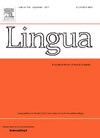框架-语义一致食品标签对非英语母语者味觉的影响
IF 1.3
3区 文学
0 LANGUAGE & LINGUISTICS
引用次数: 0
摘要
许多研究考察了公式化语言与非公式化语言的非母语加工;然而,这是第一个研究相关现象的研究:非本地加工的框架语义一致与不一致的近同义词食品标签和食品的组合。具体来说,254名欧洲消费者参加了在商店购买的薯片和苹果的口味测试,这些薯片和苹果被视为新奇的产品,并带有虚构的、框架语义上一致的品牌名称,其中包含近义词“脆脆的”和“脆脆的”。线性回归分析显示,消费者对食物的看法的效价不受框架-语义一致性的影响。相比之下,感知味觉受英语优势介导,在框架-语义一致条件下产生正相关,在框架-语义不一致条件下产生负相关。这些结果与之前对英语母语者的研究结果形成对比,表明人们对近义词不同语义框架的认识随着英语优势的增加而发展。此外,它们具有现实意义,因为英语经常用于食品广告,而不管特定市场的主导语言是什么。本文章由计算机程序翻译,如有差异,请以英文原文为准。
Effects of frame-semantically (in)congruent food labels on taste in non-native English speakers
Many studies have examined the non-native processing of formulaic versus non-formulaic language; however, this is the first study to investigate a related phenomenon: the non-native processing of frame-semantically congruent versus incongruent combinations of near-synonymic food labels and foods. Specifically, 254 European consumers participated in taste tests of store-bought potato chips and apples presented as novel products with fictitious, frame-semantically (in)congruent brand names containing the near-synonyms crispy and crunchy. Linear regression analyses revealed that the valence of consumers’ thoughts about foods remained unaffected by frame-semantic (in)congruence. In contrast, perceived taste was mediated by English dominance, producing a positive correlation in the frame-semantically congruent condition and a negative correlation in the frame-semantically incongruent condition. These results contrast with previous research on native speakers of English, suggesting that awareness of the distinct semantic frames of near-synonyms develops with increasing English dominance. Furthermore, they have real-world implications because English is often used to advertise food products, regardless of the dominant language(s) in a particular market.
求助全文
通过发布文献求助,成功后即可免费获取论文全文。
去求助
来源期刊

Lingua
Multiple-
CiteScore
2.50
自引率
9.10%
发文量
93
审稿时长
24 weeks
期刊介绍:
Lingua publishes papers of any length, if justified, as well as review articles surveying developments in the various fields of linguistics, and occasional discussions. A considerable number of pages in each issue are devoted to critical book reviews. Lingua also publishes Lingua Franca articles consisting of provocative exchanges expressing strong opinions on central topics in linguistics; The Decade In articles which are educational articles offering the nonspecialist linguist an overview of a given area of study; and Taking up the Gauntlet special issues composed of a set number of papers examining one set of data and exploring whose theory offers the most insight with a minimal set of assumptions and a maximum of arguments.
 求助内容:
求助内容: 应助结果提醒方式:
应助结果提醒方式:


